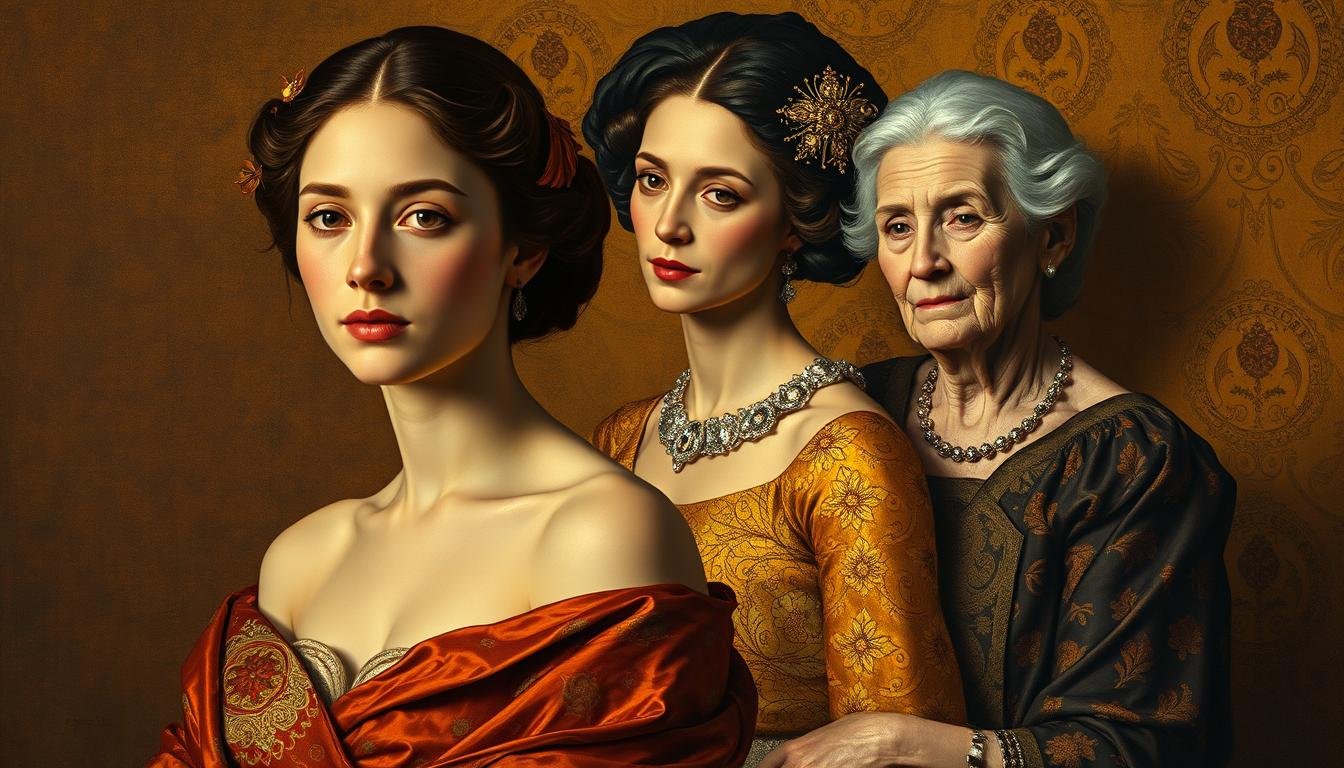Gustav Klimt’s “The Three Ages of Woman” isn’t just art—it’s a mirror reflecting life’s fleeting beauty. Created in 1905, this 180 cm × 180 cm oil-on-canvas masterpiece distills existence into three figures: a sleeping child, a youthful mother, and an elderly woman. But how does Klimt transform paint into poetry about mortality and meaning?
As a Vienna Secession pioneer, Klimt layered gold-leaf symbolism with raw emotion. Neutral tones frame the central trio, while swirling patterns suggest life’s constant motion. The child’s innocence glows against the elder’s fading form—a stark contrast using color psychology.
This work marked Klimt’s shift toward allegory after his “Golden Phase.” Critics initially dismissed its frank portrayal of aging. Yet today, it hangs in Rome’s Galleria Nazionale as a testament to art’s power to confront time itself.
Key Takeaways
- Completed in 1905, Klimt’s oil painting measures 180 cm × 180 cm
- Uses symbolic colors and figures to represent life stages
- Part of Klimt’s allegorical period after his gold-leaf works
- Central trio shows youth, motherhood, and old age
- Displayed at Rome’s Galleria Nazionale d’Arte Moderna
- Exemplifies Vienna Secession’s avant-garde style
Artistic Legacy and Symbolism in Klimt’s Masterpiece
Debuting at Berlin’s 1905 Deutsche Künstlerbund exhibition, this work sparked debates about mortality through radical visual storytelling. Klimt’s break from traditional academic art became evident as he fused Vienna Secession ideals with deeply personal symbolism.
Historical Context and the Vienna Secession
As co-founder of the Vienna Secession, Klimt championed artistic freedom against conservative norms. The movement’s motto – “To every age its art” – echoes in the painting’s layered motifs. Acquired by Italy’s Galleria Nazionale d’Arte Moderna in 1912, it gained recognition as a bridge between symbolism and modernism.
Symbolic Use of Colors and Ornamentation
Cool azure hues envelop the youthful figure, suggesting boundless potential. Earthy ochres drape the elderly subject, mirroring life’s inevitable decay. Swirling patterns between them mimic cellular structures, visualizing existence’s cyclical rhythm. Klimt’s gold-free palette here marked a departure from his earlier style, using texture rather than metallic shine to convey depth.
Technical Innovations in “the three ages of woman”
Klimt’s approach transformed oil painting into a tactile experience. The monumental 180 cm × 180 cm canvas required precise execution. He built layers using impasto techniques, creating peaks that catch light like life’s fleeting moments.
Oil on Canvas and Impasto Techniques
Thick brushstrokes gave figures dimensional presence. Klimt mixed solvents to reduce gloss, achieving a matte finish that softens transitions between youth and age. This method allowed subtle shifts in skin texture—smooth for the child, cracked for the elder.
Strategic paint application guided viewers’ eyes. Dense impasto in the central figures contrasts with flatter background strokes. The technique mirrors life’s intensity against time’s steady march.
Integration of Gold Leaf and Decorative Motifs
Though less prominent than earlier works, gold accents appear in swirling patterns. Klimt applied metallic paints sparingly, letting warmth emerge from cool tones. Geometric shapes near the figures’ heads suggest celestial guidance.
Decorative elements serve dual purposes. Floral motifs symbolize growth, while angular lines hint at mortality. This balance showcases Klimt’s ability to merge opulence with raw emotional truth.
These innovations bridged traditional craftsmanship and modernist experimentation. The artwork’s layered textures invite viewers to ponder creation itself—each stroke a deliberate choice in life’s unfolding story.
Cultural Impact and the Evolution of Art Narratives
When Klimt’s vision crossed borders, it ignited global conversations about existence. The artwork’s 1910 Venice Biennale debut shocked audiences with its unflinching portrayal of life’s transient nature. Critics praised its boldness, awarding it a gold medal at Rome’s 1911 International Exhibition.
Reception at International Exhibitions
Displayed alongside avant-garde works, Klimt’s creation challenged beauty standards. Its journey from Vienna to Rome’s Galleria Nazionale d’Arte Moderna mirrored society’s shifting values. Curators noted how viewers lingered on the old woman’s sagging skin, a radical departure from idealized forms.
Influence on Modern Art and Art Nouveau
The painting’s swirling patterns became blueprints for Art Nouveau designers. Architects borrowed Klimt’s organic shapes for ironwork and stained glass. Young artists reinterpreted his symbolic use of colors to explore emotional depth in abstract works.
Allegory of Life, Love, and Death
Klimt framed motherhood as life’s apex, contrasting the child’s vibrancy with aging’s inevitability. Floral motifs near the young woman’s hair suggest blossoming potential, while cracked textures around the elder whisper mortality. This visual poetry transformed personal journeys into universal truths.
Today, the work’s cyclical narrative inspires digital artists and filmmakers. Its presence in Rome’s national collection ensures Klimt’s voice still shapes how we visualize time’s passage through creative expression.
Conclusion
Gustav Klimt’s 1905 oil painting captures life’s fleeting phases through radical artistry. Housed in Rome’s Galleria Nazionale, this masterpiece distills existence into youth, motherhood, and aging. Its layered textures—thick impasto strokes and symbolic hues—reveal technical daring still studied today.
Cool blues cradle the child, while weathered ochres cloak the elder. Klimt’s departure from gold-leaf opulence sharpened focus on raw human transitions. Swirling patterns between figures mirror nature’s rhythms, binding birth and decay into one visual poem.
The work’s global exhibitions reshaped art narratives, proving beauty thrives in unflinching truth. As a Vienna Secession pioneer, Klimt fused craftsmanship with allegory, inspiring modernist movements. His portrayal of life’s cycle remains timeless—a mirror reflecting our shared journey.
Through its bold contrasts and universal themes, this painting endures as cultural touchstone. Visitors to Rome still pause before its weathered forms, finding fresh meaning in Klimt’s century-old meditation on mortality and meaning.
FAQ
What symbolic elements define Gustav Klimt’s The Three Ages of Woman?
Klimt uses gold leaf, abstract patterns, and contrasting colors to symbolize life’s stages. The young child represents innocence, the mother embodies nurturing, and the elderly figure reflects mortality. Ornamental motifs tie the figures to Art Nouveau’s decorative style.
How did Klimt incorporate technical innovations in this painting?
He blended oil on canvas with impasto techniques for texture. Gold leaf accents and intricate floral motifs create a shimmering effect, merging fine art with craft—a hallmark of the Vienna Secession movement.
Where is The Three Ages of Woman displayed today?
The artwork resides at Rome’s Galleria Nazionale d’Arte Moderna. It gained acclaim after exhibitions like the 1911 International Art Show, where Klimt’s allegorical themes resonated with modernist audiences.
How does the painting reflect themes of life and death?
The trio—child, mother, and elder—mirrors the human cycle. Klimt contrasts vibrant hues for youth with muted tones for aging, emphasizing impermanence. The work’s emotional depth aligns with Symbolism’s focus on existential themes.
What role did the Vienna Secession play in Klimt’s style?
The movement rejected traditional academic art, embracing avant-garde techniques. Klimt’s use of decorative motifs and flattened perspectives in The Three Ages of Woman exemplifies this break, influencing later Art Nouveau designs.







